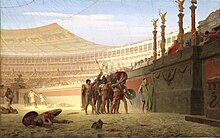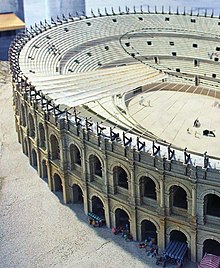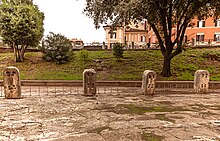Velarium

A velarium (plural: velaria ) was a large ring-shaped canvas tarpaulin. On the outer edge of the top floor of the Colosseum in Rome , 240 vertical masts were erected, on which the huge awning could be raised so that the spectators in the stands inside the Colosseum were shaded in the intense heat.
construction
The velarium was a great technical masterpiece at that time. It was linked together from numerous tarpaulins, each of which had to be cut differently due to the elliptical floor plan. Therefore, the extremely complicated construction was operated by very experienced sailors from the imperial fleet . This fleet unit was stationed at Misenum on the Gulf of Naples and was specially called to Rome for handling. Their main task was, in particular, to pull the velarium back in quickly when the winds were too strong, in order to prevent the construction from collapsing and thus endangering the public.
The Colosseum had 240 mast brackets on the upper edge of the building. The mast brackets were designed so that the masts could not move in their sockets. The distance between the individual brackets is smaller than in other amphitheaters of antiquity . Both should guarantee the stability of the opened sun sail.
The inner edge of the sail construction formed an elliptical ring that was placed on the floor of the amphitheater. 240 ropes ran from this ring over the masts to the outside area of the arena, where they were probably anchored to 160 stone bollards. Winches were used there to stretch and stabilize the velarium. The stretching was laborious and dragged on for several days. Up to 1000 men were needed to assemble the velarium.
distribution

In addition to the Roman Colosseum, such vela or velaria were found in many theaters and amphitheatres of the Roman Empire . The particularly well-preserved mast supports (pan holes and consoles) in the amphitheaters of Nîmes and Pula still bear witness to this today . When games were announced, it was sometimes expressly mentioned that the sun sails would be raised ( Latin vela erunt - "There will be sun sails").
In art
In art, until the beginning of the 20th century , velarium referred to a horizontally stretched canvas either in a room with a skylight, such as an exhibition or painting room, or across a street or a square.
If it was made for a festive occasion, the velarium was often decorated with ornaments or figurative paintings by important artists. It was not customary to display the velarium in public beyond the current daily event.
literature
- Rainer Graefe: Vela erunt: The tent roofs of the Roman theaters and similar facilities . Zabern, Mainz 1979. ISBN 3-8053-0361-0
- Siegfried Bühner: Textile sun protection in early times and antiquity . Pina-Design.de, published November 3, 2012, accessed April 16, 2013
- Luciana Jacobelli: Gladiators at Pompeii , L`erma di Bretschneider, Roma 2003, ISBN 88-8265-249-1 , here pp. 34–36
Individual evidence
- ↑ Enigme tenace - Comment pouvait-on tirer le velum dessus? , benevolent essay on René Chambon's velarium reconstruction, site velum-colisee.com, accessed 2014
- ↑ http://amphi-theatrum.de/1990.html

